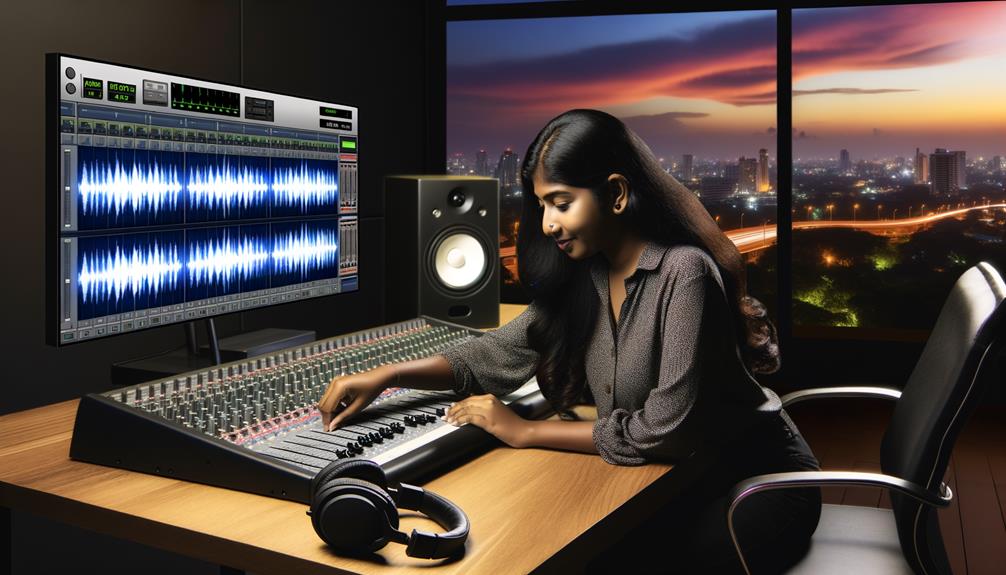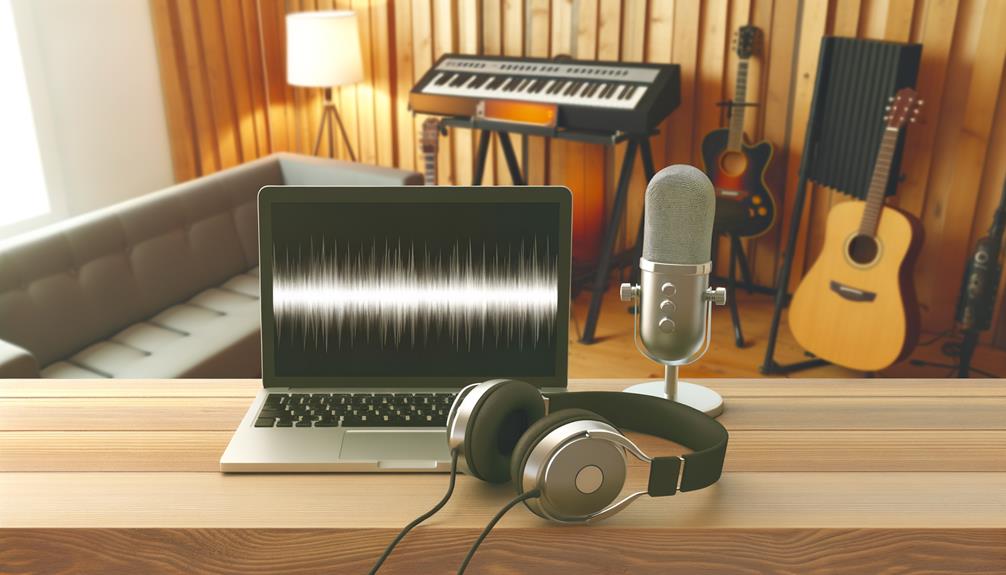No products in the cart.
For streaming audio success, you must manage loudness to match platform-specific norms. Spotify and YouTube both recommend –14 LUFS for best audio dynamics and consistent quality. Apple Music, however, adheres to a –16 LUFS standard to preserve a balanced mix and dynamic range. Genre variations are significant; for example, rock and pop typically range from -9 to -13 LUFS to maintain energy and impact. Conversely, jazz and classical target a quieter -16 to -20 LUFS, respecting natural dynamics. Using True Peak meters and proper gain staging prevents distortion and guarantees compliance. There’s more to learn about mastering these levels effectively.
Key Takeaways
- Target -14 LUFS for optimal audio quality on Spotify and YouTube.
- Aim for -16 LUFS to meet Apple Music’s standard for dynamic preservation.
- Adjust to -9 to -13 LUFS for rock and pop to maintain energy and impact.
- Set electronic and dance music between -6 to -9 LUFS for powerful rhythms.
- Preserve natural dynamics in jazz and classical by targeting -16 to -20 LUFS.
Understanding Loudness Normalization
Loudness normalization, an essential process for streaming platforms, automatically adjusts the playback volume to guarantee a consistent and balanced listening experience across various tracks. This technique is pivotal in managing audio dynamics, ensuring that no track is perceptibly louder than another, thus maintaining the artistic integrity and intensity the creator intended.
Streaming platforms deploy this process by adhering to LUFS standards (Loudness Units Full Scale), a universal scale that measures audio loudness. This standardization is important as it mitigates sudden volume jumps that can disrupt your listening experience. By normalizing audio to a specific LUFS value, platforms ensure that the loudness level of each track is consistent, irrespective of its original mixing levels. This means you won’t have to reach for the volume control every time a new track plays.
Understanding the role of LUFS in loudness normalization allows you to appreciate the technology that aids in delivering a more seamless audio experience. It’s not just about preventing startling volume changes; it’s about preserving the dynamic range while ensuring every track plays back at a volume that feels right within the context of continuous playback. This technical equilibrium is important for both listener enjoyment and artist visibility on streaming platforms.
Optimal LUFS for Spotify
Understanding the role of LUFS in loudness normalization brings us to Spotify’s recommendation of -14 LUFS for the best audio streaming quality. Mastering your tracks to this level isn’t just about hitting a number; it’s about guaranteeing audio dynamics and mastering techniques are optimized to deliver your music as you intend it to sound. By adhering to this standard, you guarantee loudness consistency across your tracks, preventing any one song from standing out due to its volume alone.
Achieving -14 LUFS means engaging in precise volume optimization during mastering. This process not only matches Spotify’s normalization parameters but also preserves the natural dynamics of your music, preventing over-compression which can lead to a loss of clarity and impact.
Here’s a quick guide to help you understand the key points:
| Aspect | Detail | Importance |
|---|---|---|
| Target LUFS | -14 LUFS (integrated) | Ensures platform compatibility |
| Consistency | Volume level uniformity across tracks | Enhances user experience |
| Dynamic Integrity | Preserves audio dynamics | Maintains artistic expression |
| Mastering | Tailored compression and limiting | Optimizes sound quality |
Mastering to Spotify’s LUFS recommendation helps your music sound its best on one of the world’s leading streaming platforms, guaranteeing that your audience enjoys every beat as you envisioned. Keep these points in mind to enhance both the technical quality and listener experience of your audio content.
YouTube Loudness Recommendations
For ideal audio uploads, YouTube recommends mastering your content to a target loudness of -14 LUFS (integrated). This standard ensures that your audio maintains high quality and consistency across various devices and listening environments. Integrated loudness, the average volume of your entire track, plays an important role in achieving a balanced audio experience for your audience.
By aligning your audio with YouTube’s loudness recommendations, you’re not just enhancing the listener’s experience; you’re also guaranteeing volume consistency. This significance is essential as it prevents audio levels from being too quiet or overwhelmingly loud compared to other content on the platform. Remember, YouTube automatically adjusts the playback volume of videos to match the -14 LUFS standard, which means mastering your tracks to this specification simplifies the normalization process and reduces the risk of dynamic range compression that can degrade your audio quality.
Adhering to these loudness guidelines won’t only improve the impact of your audio on viewers but also contribute to a more uniform audio environment on YouTube. This practice is important for content creators aiming for professional-grade audio quality and listener satisfaction.
Mastering for Apple Music
When mastering for Apple Music, you must follow their strict loudness standard of –16 LUFS to make sure your tracks aren’t turned down during playback.
You’ll need to utilize precise compression techniques to maintain peak volume levels without sacrificing dynamic range.
Employing advanced LUFS meters will help you accurately measure and adjust the integrated loudness, allowing your music to meet Apple Music’s specifications effectively.
Apple Music Standards
Mastering engineers must target a balanced mix at -16 LUFS to comply with Apple Music’s loudness standard for the best audio quality. Achieving this guarantees your tracks maintain their intended dynamics and clarity, vital for listener satisfaction and meeting streaming platform requirements.
- Monitor Integrated Loudness: Regularly check levels to guarantee compliance with -16 LUFS.
- Understand Dynamic Range: Preserve the natural dynamics of the recording.
- Utilize Appropriate Mastering Techniques: Apply limiting and compression wisely.
- Consistency Across Tracks: Aim for uniform loudness to enhance the listening experience.
- Quality Control: Conduct thorough final listens to identify any issues with loudness consistency or audio quality.
Adhering to these guidelines is essential for mastering success on Apple Music.
Optimal Volume Levels
Achieving the –16 LUFS standard in Apple Music mastering guarantees that your tracks deliver a balanced and consistently high-quality audio experience. This specific loudness level preserves the natural audio dynamics of your music, ensuring that each element stands out without overpowering others.
By adhering to this standard, you prevent your tracks from sounding excessively loud or quiet compared to others on the platform, which is essential for maintaining volume consistency.
To master this, you’ll need to employ precise loudness adjustments and equalization techniques. Adjusting frequencies and managing peaks effectively will help you meet the -16 LUFS target while keeping your music’s dynamic range intact. This approach not only meets Apple Music’s requirements but enhances listener engagement.
Compression Techniques
To effectively master your tracks for Apple Music, it’s important to utilize advanced compression techniques that guarantee your audio meets the -16 LUFS standard without sacrificing dynamic quality. Your artistic choices in compression not only influence the final loudness but also preserve the emotional impact of the music.
- Multiband Compression: Tailor compression settings across different frequency bands for precise dynamic control.
- Parallel Compression: Blend compressed and uncompressed signals to enhance dynamics without overt harshness.
- Attack and Release Settings: Optimize these parameters to maintain natural sound while controlling peaks.
- Knee Settings: Adjust the compression curve’s sharpness to smooth shifts between compressed and uncompressed areas.
- Gain Staging: Properly stage gain levels to maintain consistency across the track and prevent unwanted distortion.
These advanced techniques are pivotal in achieving high-quality audio for Apple Music.
Dynamic Range in Streaming
As you explore the concept of dynamic range in streaming, it’s essential to understand how it impacts the listener’s experience. You’ll find that maintaining a broad dynamic range can greatly enhance musical clarity and listener engagement.
Additionally, we’ll discuss how compression techniques can be applied judiciously to avoid the pitfalls of over-compression, which can detract from audio quality on streaming platforms.
Understanding Dynamic Range
Understanding dynamic range in streaming is crucial, as it represents the difference between the loudest and softest parts of an audio signal, influencing both audio quality and listener experience. Here’s why mastering this concept matters:
- Audio Dynamics: Properly managed dynamics guarantee that music retains its emotional impact without causing fatigue.
- Mastering Techniques: Judicious use of dynamic range compression balances loudness while preserving clarity and detail.
- Loudness Perception: Over-compression can make tracks feel lifeless; maintaining dynamic range helps preserve the vibrancy and authenticity of the music.
- Music Quality: High dynamic range contributes to a richer, more engaging listening experience.
- Streaming Standards: Platforms utilize loudness normalization, impacting how dynamic range is perceived during playback.
Impact on Listener Experience
Maintaining dynamic range in streaming not only preserves the integrity of music but also greatly enhances your listening experience. When you listen to tracks with adequate dynamic range, you’re experiencing the full spectrum of sound as intended by the artists.
This range, the span between the softest and loudest parts, is essential for creating a balanced and engaging auditory experience. Without it, music can sound flat and lifeless, reducing both listener engagement and emotional impact.
Compression Techniques Explained
To optimize your listening experience, streaming services employ compression techniques that carefully balance dynamic range with consistent loudness levels. These techniques are essential for guaranteeing that the audio you hear maintains high quality, regardless of the listening environment.
- Dynamic Range Compression: Reduces contrasts between the loudest and softest sounds, enhancing audio consistency.
- Loudness Consistency: Guarantees that all audio tracks maintain a uniform loudness, critical for listener satisfaction.
- Audio Quality Preservation: Balances loudness without sacrificing clarity and detail.
- Mastering Tips: Proper application of compression settings is pivotal during the mastering phase to prevent over-compression.
- Compression Benefits: Aids in delivering a more impactful and engaging listening experience by smoothing out volume spikes and dips.
Genre-Specific Loudness Tips
Adjusting loudness levels according to genre-specific guidelines ensures your audio tracks deliver excellent sound quality and listener engagement. When tackling mixing dynamics and mastering differences, it’s essential to take into account the genre-specific loudness and its impact on audio quality.
For rock and pop, target an integrated loudness of -9 to -13 LUFS. This range helps maintain the genre’s characteristic impact and energy, ensuring that every power chord and catchy hook captivates the listener.
Electronic and dance music demand higher loudness, around -6 to -9 LUFS, to enhance their driving rhythms and potent bass elements. This loudness level maximizes the genres’ pulsating energy, crucial for club tracks and festival anthems.
Conversely, jazz and classical music require a more delicate touch, with recommended levels between -16 to -20 LUFS. Lower loudness preserves the natural dynamics and acoustic richness, crucial for conveying the nuanced performances typical in these genres.
Hip-hop and rap benefit from levels around -7 to -11 LUFS, optimizing the clarity of powerful vocals and deep basslines, while country and folk should hover between -12 to -16 LUFS, allowing for clarity in intricate instrumentation and vocal harmonies.
Peak Levels and Distortion Prevention
While setting the right loudness levels for different genres improves listener engagement, you also need to manage peak levels to prevent distortion and guarantee high-quality audio playback. Exceeding 0 dBFS can result in digital clipping, a surefire way to degrade your audio. By keeping peak levels in check, you’re maintaining the clarity and integrity of your sound.
To guarantee your audio remains pristine, consider these strategies:
- Utilize True Peak meters: These specialized tools measure inter-sample peaks, helping you avoid clipping that traditional peak meters might miss.
- Implement proper gain staging: Adjust your levels throughout the signal path to prevent any single point from exceeding 0 dBFS.
- Apply soft clipping: When needed, use soft clipping to round off peaks gently, preserving audio quality while controlling loudness.
- Adopt limiting judiciously: A limiter can be a critical tool in your arsenal, set just below 0 dBFS to catch unexpected peaks without affecting overall dynamics.
- Regularly review mastering guidelines: Stay updated with the latest mastering tips and norms for streaming platforms to keep your levels optimized.
Frequently Asked Questions
What Is a Good LUFS Level for Streaming?
To guarantee your streams sound great, aim for -14 LUFS. Using metering tools helps maintain this level while preserving dynamic range, vital for quality across platforms like Spotify and YouTube.
What Are Proper Audio Levels for Streaming?
For proper streaming audio levels, you’ll need to aim for around -14 to -16 LUFS. Use metering tools to guarantee dynamic range isn’t compromised, maintaining clarity and consistency across different platforms.
How Loud Should Music Be on Stream?
For peak streaming performance, you should keep your music at around -14 LUFS. This level balances dynamic range and minimizes compression effects, ensuring consistent audio quality across various platforms like Spotify and YouTube.
Is 14 LUFS Loud Enough?
Yes, 14 LUFS is loud enough as it balances dynamic range and loudness. You’ll need metering tools to guarantee precise levels, maintaining clarity and impact without risking distortion across various streaming platforms.
Conclusion
You’ve explored the essentials of mastering audio for streaming platforms. By following recommended LUFS levels—such as -14 for Spotify and slightly varied for YouTube and Apple Music—you guarantee your tracks meet industry standards.
Remember, maintaining dynamic range while avoiding peak levels that cause distortion is vital. Tailor your mastering approach based on genre specifics to enhance listener experience.
Embrace these practices to achieve professional, consistent audio quality across all streaming services.




